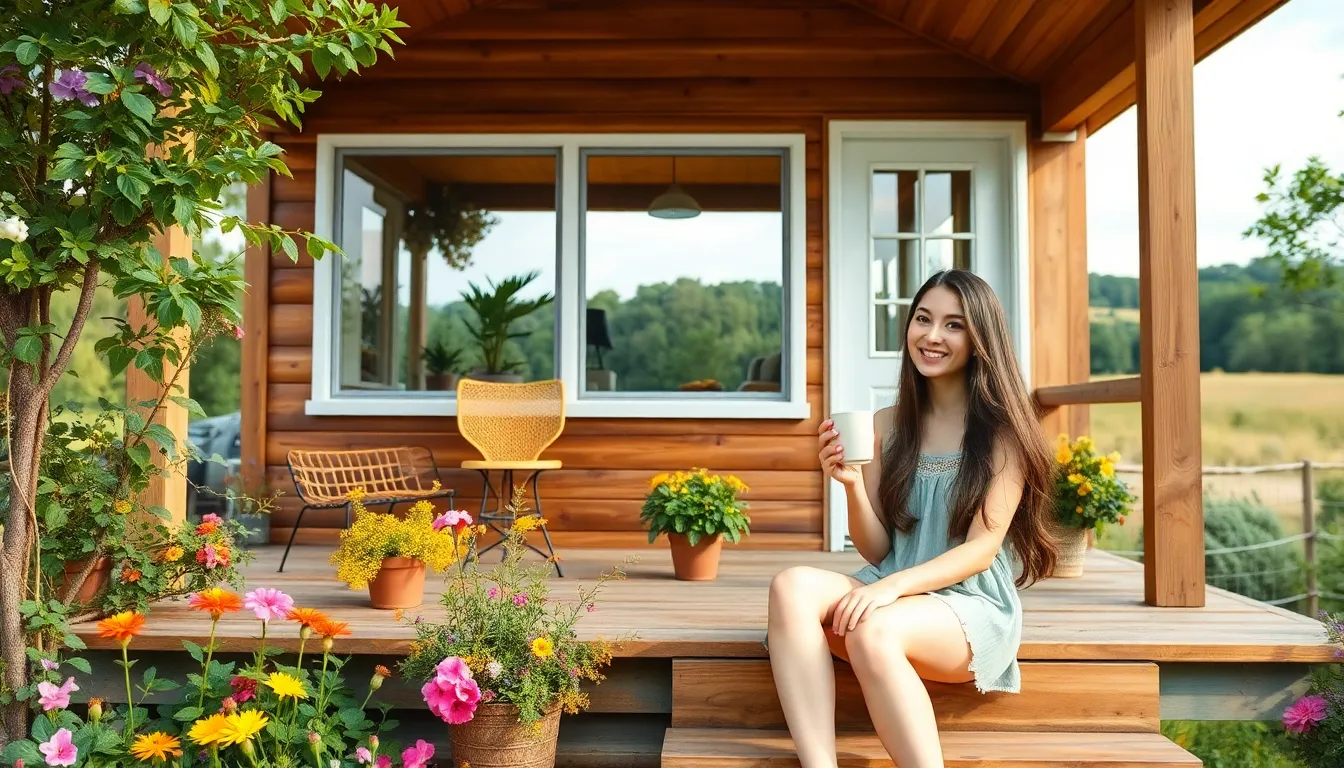Table of Contents
ToggleIn a world that seems to be getting bigger and busier by the day, tiny homes are making a splash that’s hard to ignore. Advocates of the tiny home movement are rallying for a lifestyle that embraces simplicity, sustainability, and a whole lot of charm. Imagine living in a space where every square foot counts and every nook has a purpose—it’s like living in a cozy, well-organized hug!
Overview of Tiny Home Advocacy
Tiny home advocacy focuses on promoting a shift toward minimalistic living. Advocates support reducing environmental impact through smaller and more efficient dwellings. One significant aspect of this movement lies in its emphasis on sustainability. Tiny homes often utilize eco-friendly materials and renewable energy sources.
Communities around the country are embracing this lifestyle choice, recognizing its benefits for individuals and the planet. A survey conducted by the American Tiny House Association indicated that 68% of respondents believe tiny homes contribute positively to environmental conservation. Additionally, a reduction in living space encourages better financial management.
Tiny home proponents often highlight the ability to reduce housing costs significantly. With the average cost of a tiny home ranging from $30,000 to $60,000, homeownership becomes accessible for many. Accessibility remains key, as these homes can accommodate various demographics, including retirees, young professionals, and families.
In local governments, advocacy efforts emphasize the importance of zoning changes. Modifications in regulations can facilitate the placement of tiny homes in diverse areas. Engaging in discussions, community members advocate for the inclusion of tiny homes in affordable housing initiatives.
Social media platforms serve as effective tools for tiny home advocacy. Groups share success stories and resources, connecting like-minded individuals. Through workshops and events, enthusiasts exchange ideas and knowledge about the tiny home lifestyle.
Overall, tiny home advocacy merges desire for simpler living with environmental responsibility. Communities become more aware of the numerous advantages associated with adopting these innovative housing solutions. The movement continues to inspire individuals seeking efficient, sustainable living options.
Benefits of Tiny Home Living
Tiny home living offers numerous advantages that attract people from various backgrounds. The concept encompasses financial savings and a reduced environmental impact, making it a compelling choice.
Financial Savings
Financial savings represent a significant benefit of embracing tiny home living. Average costs for tiny homes range from $20,000 to $60,000, substantially lower than the national median home price of around $400,000. Lower utility bills emerge from reduced energy consumption, making monthly expenses more manageable. Many tiny homeowners experience less financial stress, allowing for increased flexibility in life choices. Smaller living spaces also necessitate fewer possessions, which can cut down on purchasing and maintenance expenses.
Environmental Impact
Environmental impact plays a crucial role in the appeal of tiny homes. Constructing smaller dwellings typically requires fewer resources and produces less waste. Many tiny homes utilize eco-friendly materials and sustainable building practices, reflecting a commitment to minimizing environmental footprints. As mentioned by the American Tiny House Association, approximately 68% of tiny home advocates believe this movement fosters conservation. Reduced water and energy use complements the overall goal of sustainability. Living in a tiny home encourages a minimalist lifestyle, which further contributes to lower overall consumption and supports a healthier planet.
Challenges Faced by Tiny Home Advocates
Tiny home advocates encounter several challenges that hinder their efforts to promote this lifestyle. These obstacles include strict regulations and community perceptions.
Zoning Regulations
Zoning regulations frequently restrict where tiny homes can be placed. Many local ordinances require minimum square footage for residential properties, making it difficult for tiny homes to comply. Advocates often push for updated zoning laws that accommodate smaller dwellings. Some areas offer tiny home communities, though they may require significant effort to establish. Progress has been made, with some municipalities relaxing restrictions, which creates opportunities for more tiny home developments.
Community Acceptance
Community acceptance presents another significant hurdle. Neighbors may express concerns about property values and aesthetics regarding tiny homes. Overcoming skepticism often requires education and outreach. Open houses and informational sessions help dispel myths associated with tiny home living. Advocates frequently highlight successful tiny home projects to demonstrate benefits. Building supportive networks within communities fosters a positive environment, encouraging acceptance and collaboration among residents.
Tiny Home Advocacy Organizations
Tiny home advocacy organizations play a vital role in promoting the benefits of living in smaller, sustainable homes. They support issues such as reducing housing costs and enhancing environmental conservation.
Key Players in the Movement
Organizations like the American Tiny House Association focus on connecting enthusiasts and advocating for policy changes. Tiny House Community and Tiny House Expedition also contribute by providing resources and educational materials. Their collective efforts help raise awareness of the tiny home movement, sparking interest from local governments and potential homeowners.
Their Contributions and Impact
Advococates engage in various initiatives, pushing for zoning law reforms to allow tiny homes in more areas. Informational sessions help educate communities on the benefits of tiny living, addressing concerns about aesthetics and property values. Moreover, these organizations document success stories, demonstrating how tiny homes have positively impacted lives and fostered sustainable lifestyles. Through these contributions, they facilitate a broader acceptance of tiny homes, influencing public perception and policies nationwide.
Future of Tiny Home Advocacy
Tiny home advocacy continues to evolve, gaining traction as more individuals recognize the benefits of minimalistic living. Organizations focus on policy reform, specifically advocating for changes in zoning laws to facilitate the establishment of tiny home communities. The American Tiny House Association and similar groups lead efforts to connect enthusiasts, pushing for legislative updates.
Innovations in construction techniques further support this movement. Sustainable practices dominate, encouraging builders to use eco-friendly materials and renewable energy solutions. As individuals prioritize lower environmental impact, tiny homes align seamlessly with these values.
Community involvement plays a critical role in shaping the future of tiny home advocacy. Active participation from local residents helps build acceptance, reducing resistance to new developments. Sharing success stories proves effective, highlighting how tiny homes can enhance neighborhoods rather than detract from property values.
Data supports the argument for tiny homes, revealing that 68% of people believe these dwellings contribute positively to environmental conservation. With cost-effective options ranging from $20,000 to $60,000, financial accessibility becomes a key selling point for potential homeowners. Advocates emphasize that tiny homes not only minimize housing expenses but also reduce overall consumption, contributing to a healthier planet.
Education remains essential in overcoming skepticism. Through open houses and informational sessions, advocates help dispel myths surrounding tiny living. These initiatives encourage broader conversations about housing options, ultimately fostering a supportive culture for tiny home communities. As awareness grows, tiny home advocacy adapts, ensuring it remains relevant in the shifting landscape of housing.
Tiny home advocacy stands at the forefront of a transformative movement that champions sustainable living and affordable housing solutions. As more people embrace minimalism, the benefits of tiny homes become increasingly clear. They offer financial freedom and a smaller ecological footprint, appealing to diverse demographics.
The push for policy reform and community acceptance is essential for the future of tiny homes. With ongoing education and outreach efforts, advocates are dismantling misconceptions and fostering a supportive environment. As awareness grows, tiny home living is poised to reshape the housing landscape, encouraging a lifestyle that prioritizes simplicity and sustainability. The journey ahead holds promise as communities unite to embrace this innovative approach to homeownership.



